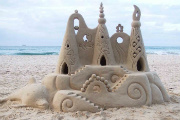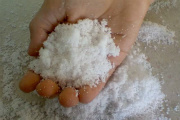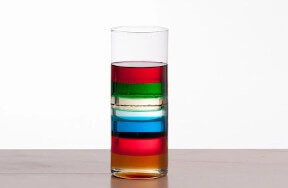Wanna do a REALLY COOL science fair project this year? Look no further than Mother Nature herself - she's been known to have some pretty bad days! This Amazing Natural Disaster project includes facts and info about hurricanes (aka cyclones or typhoons) and the science behind them, an experiment you can do yourself and helpful suggestions for other things to research, make, draw, create and include in your project!
Hurricanes: Pressure-Cooker Storms
Think of our world’s tropical seas as steaming pots of water cooked by the sun and stirred by the turning of the Earth on its axis – this is the basic recipe for hurricanes, which are born and sustained by warm water and die within a few days of leaving it. Most Atlantic Ocean hurricanes form in the late summer off the coast of West Africa. They travel west, growing in strength as they feed off the warm ocean water. The winds start to spiral as a result of the Earth’s rotation. The storm grows and grows, finally hitting wind speeds of 74 mph or more – an official hurricane.
 Hurricanes: Pressure-Cooker Storms
Hurricanes: Pressure-Cooker Storms
Hurricane In A Bottle
Many large thunderstorms come together over ocean water and begin to swirl like a vortex. When this vortex becomes powerful enough, it is called a hurricane. It's easy to make your own model of a hurricane using plastic soda bottles:
- Fill the soda bottle to the top with water. If you do not have access to a sink nearby or you don't want to move the dinner party to the kitchen, use a large pitcher to fill the bottle.
- Here's the challenge: How long will it take to empty all of the water in the bottle into the pitcher on the table? Record your prediction on a piece of paper.
- Without squeezing the sides of the bottle, time how long it takes to empty all of the water. You might want to repeat this several times to validate your time.
- Fill the bottle to the top with water just as you did before. This time swirl the water by moving the bottle in a clockwise or counter-clockwise motion while the water is pouring out. Keep swirling the water until you see the formation of what looks to be a tornado! The water begins to swirl in shape of a vortex and flows out of the bottle very quickly.
Twist Of Color: Try adding two ounces of colored lamp oil to the water. Lamp oil is available at most department stores were oil lamps are sold. The oil will float on the surface of the water since oil is less dense than water. When the oil and water swirl together, the less dense oil travels down the vortex first and creates a colored tornado effect.
 Make your own hurricane in a bottle
Make your own hurricane in a bottle
Other Things To Include
You didn’t think we’d do all of the work for ya, did you? You’ll definitely have to do some legwork to make this science fair project complete. Here are some suggestions for what else you can do:
- When it comes to hurricane hotspots, Florida is the undisputed world champion, but scientists are still trying to figure out why the state gets hit with more hurricanes than other places on Earth. Do some research and explain your own theory for this phenomenon.
- Draw, build or even make a video illustrating the cross-section of a hurricane (i.e., its innards and all the stuff it’s made of).
- Do a biography on Joseph Duckworth, an air force pilot who flew his plane straight through the outer wall of a hurricane – on purpose.
- Research Hurricane Camille and the Former Richelieu Apartment Building.
- Create a report about Hurricane Katrina; make sure to research all stages of this devastating hurricane and describe what happened before, during and after.
- Find out what hurricane was the STRONGEST of all time; the BIGGEST of all time; and the DEADLIEST of all time. (Hurricane Hint: These three categories relate to three different hurricanes – not all on Earth.)
- Make your own Hurricane Hall Of Fame & Fun Facts, including some of the following hurricane-related topics: Ibis birds, which are always the last to leave before a hurricane hits; Hurricane Gilbert, the strongest hurricane of all time; the policies throughout history on how hurricanes should be named. (Hurricane Hint: There’s a pattern.)
 Hurricanes can be very dangerous
Hurricanes can be very dangerous
Related Stories:
- Science Fair Project Idea: Amazing Natural Disasters :: Tornadoes
- What Are Clouds?
- All About Hurricanes
- Planet Overview: Jupiter

































